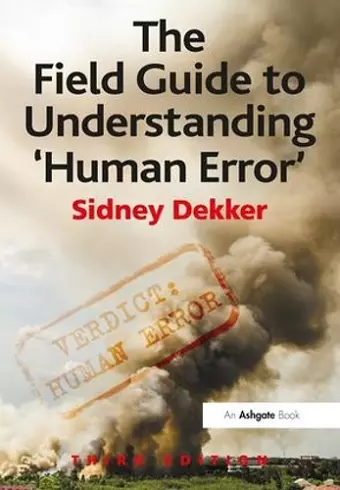The Field Guide to Understanding 'Human Error'
Format:Paperback
Publisher:Taylor & Francis Ltd
Published:28th Dec '14
Should be back in stock very soon
This paperback is available in another edition too:
- Hardback£125.00(9781472439048)

When faced with a ’human error’ problem, you may be tempted to ask 'Why didn’t these people watch out better?' Or, 'How can I get my people more engaged in safety?' You might think you can solve your safety problems by telling your people to be more careful, by reprimanding the miscreants, by issuing a new rule or procedure and demanding compliance. These are all expressions of 'The Bad Apple Theory' where you believe your system is basically safe if it were not for those few unreliable people in it. Building on its successful predecessors, the third edition of The Field Guide to Understanding ’Human Error’ will help you understand a new way of dealing with a perceived 'human error' problem in your organization. It will help you trace how your organization juggles inherent trade-offs between safety and other pressures and expectations, suggesting that you are not the custodian of an already safe system. It will encourage you to start looking more closely at the performance that others may still call 'human error', allowing you to discover how your people create safety through practice, at all levels of your organization, mostly successfully, under the pressure of resource constraints and multiple conflicting goals. The Field Guide to Understanding 'Human Error' will help you understand how to move beyond 'human error'; how to understand accidents; how to do better investigations; how to understand and improve your safety work. You will be invited to think creatively and differently about the safety issues you and your organization face. In each, you will find possibilities for a new language, for different concepts, and for new leverage points to influence your own thinking and practice, as well as that of your colleagues and organization. If you are faced with a ’human error’ problem, abandon the fallacy of a quick fix. Read this book.
Comments on the Third Edition: ’It's in the world's best interest to read Dekker’s book. The Field Guide is nothing short of a paradigm shift in thinking about human error, and in my domain of software and Internet engineering, it should be considered required reading. This Third Edition is much better than the Second, and the layout of the material is far more accessible.’ John Allspaw, SVP, Infrastructure and Operations, Etsy ’If you design equipment or operating procedures, if you investigate accidents or deal with safety, this is an essential book. Sidney Dekker, a leading world authority on "human error" has enhanced his already exceptional "Field Guide" to be a concise, readable guide to both design of equipment and procedures and also the analysis of mishaps. The label "human error" is misleading and its use prevents discovery and correction of the true underlying causes of incidents. So read about hindsight bias, about the difference between the view from inside the system rather than from outside, and about difference between the blunt end (where you should do your work) and the sharp end (where people tend to focus). Read, learn, and put these ideas into practice. The results will be fewer incidents, less damage, less injury.’ Don Norman, author of The Design of Everyday Things ’The Third Edition of Sidney Dekker's Field Guide to Understanding Human Error provides a solid practical framework for anyone wanting to make sense of safety science, human factors analysis, and the New View approach to conducting investigations of incidents and accidents. The trademark direct and passionate style that is common in Dekker's work focuses on the circumstances of frontline operators and managers working in complex systems, as well as the challenges of the safety investigator. Dekker does not mince his words ("Any human factors investigation that does not take goal conflicts seriously does not take human work seriously") and is clearly suppor
ISBN: 9781472439055
Dimensions: unknown
Weight: 360g
248 pages
3rd edition